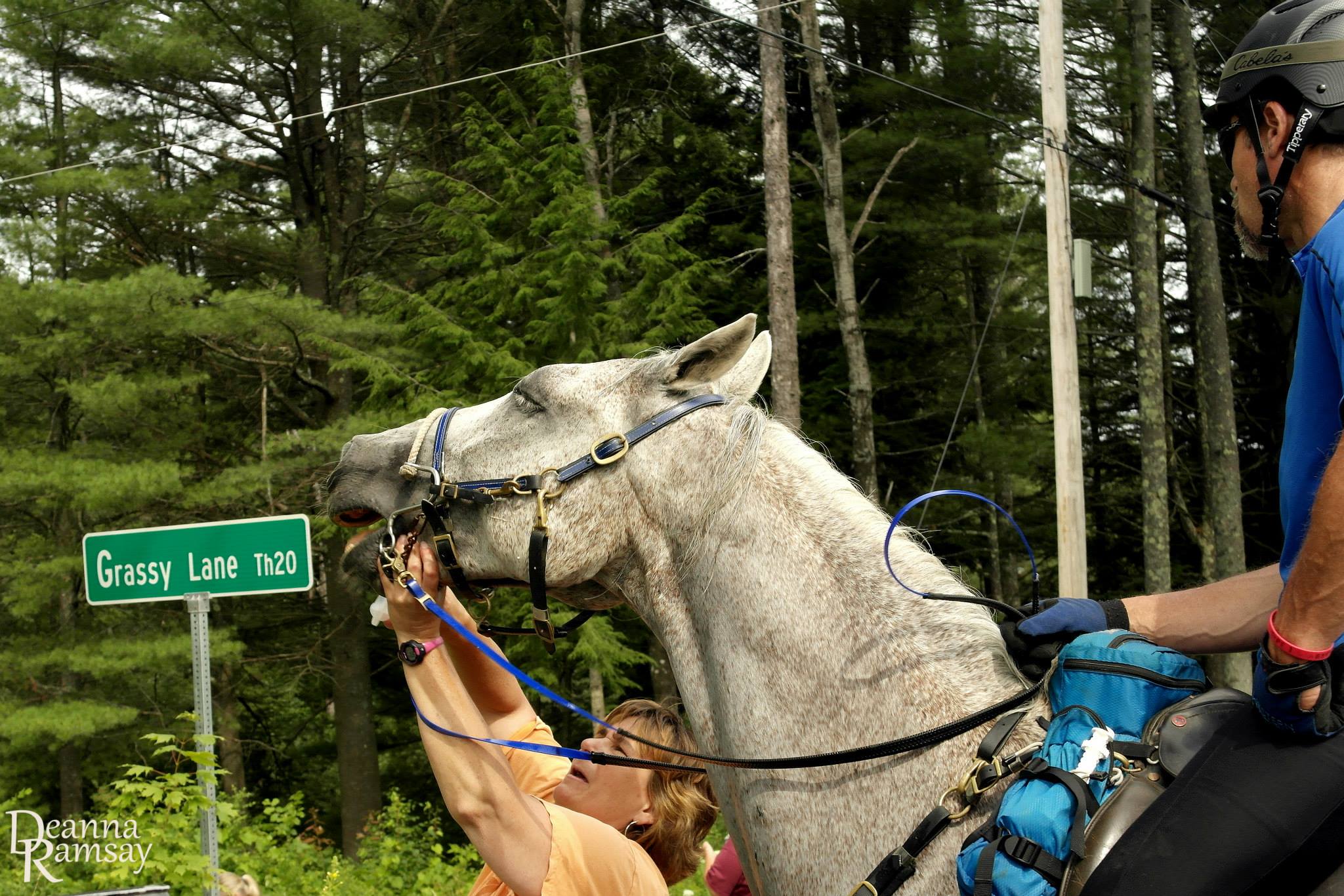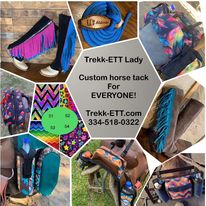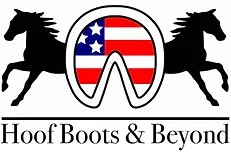DISCLAIMER: There are few topics endurance riders share opposing views on more than electrolytes, electrolyte-ing protocol, and even whether to electrolyte at all. So as I write this blog, please note that this is just our experience from over fifteen years of competition, approximately 6 or 7,000 miles of competition experience and having started and brought along 3 (and on the hairy edge of our fourth) 100-mile endurance horses, and a couple of Decade Team horses. We also ride in the Northeast Region where the summertime brings significant heat and drippy, awful humidity, but have ridden a couple of XP rides in Utah where the relative humidity is significantly lower. But we get SO many questions about electrolytes, and over the years with our horses have made so many mistakes (that we wish others to avoid), and in recent years have learned so much by working with veterinarians and top competitors in Beyond the Basics AERC Clinics, that I thought it would be good to share what works for us, what hasn’t and some principles that we think are pretty widely agreed upon. However, you should take everything here with a big grain of salt (pun fully intended!) as some might disagree, some vehemently, and the bottom line in our sport is Whatever Works for you and your horse is precisely what you should do.
So let’s start at the beginning and define electrolytes …
Electrolytes are salts that are found in mammalian blood and perform key functions. When we talk about electrolytes and endurance sports, we focus on five electrolytes: Sodium, Chloride, Magnesium, Potassium and Calcium. Each of them are critical, each perform roles within the body that are key not only to optimal athletic performance, but survival. [For example, I conduct safety training on a chemical called Hydrofluoric Acid, an extremely dangerous acid used to etch glass that causes fatalities not by burning an employee, but by binding calcium and/or magnesium in the blood, causing heart failure (from hypocalcemia) or multi-organ failure (from hypomagnesia). Exposures cause employee deaths by directly impacting electrolyte function. Critical stuff requiring the utmost respect.]
Sodium Chloride (NaCl) is what we all know as table salt. So electrolytes, by their nature, will contain a significant percentage of the same stuff that makes our Lay’s Potato Chips so addictive. (Or is it the crispy, fried nature of these goodies that does that?)
Magnesium (Mg), Potassium (K) and Calcium (Ca) are found in various forms in different electrolyte formulations, but there are compounds that are more or less ‘bioavailable’ and in general, the electrolyte formulas researched and sold by companies who sell to sporthorse/endurance riders are based on the balance of salts found in, you guessed it, horse sweat. Most of the endurance tack suppliers sell electrolytes formulated for horses in our sport so those are typically what I recommend riders use. (And there are many brands out here. We use what has worked for us for a long time with tweaks here and there. We go with the philosophy that if “it ain’t broke” we aren’t going to fix it, but there are many roads to Rome.)
The electrolytes impact one another. Deficiencies in one can mimic a deficiency in another. An influx of an isolated electrolyte, let’s say potassium, can then cause a change in another electrolyte’s balance, resulting in a whole new symptom. They are also pesky things to monitor in blood because calcium, for example, is so rigorously controlled by the body by a process called “homeostasis.”
Electrolytes are complex elements! (But let’s try to keep this simple. No one wants to hear how to build a watch when all they want to know what time it is … )
So let’s chat about sodium. Sodium has some interesting characteristics that endurance riders (and horse owners in general) should understand. One is that sodium (which we often provide to our horses in the form of sodium chloride or “table salt”) is an acquired taste. What this means is that you can easily get a horse to consume 3-4 ounces of salt per day in their feed, but you have to gradually increase the amount of salt in order to do so. If you’ve not been feeding salt and put 4 ounces in tonight’s rations, it’s a safe bet that your horse will refuse to eat it.
A few other facts/myths on Sodium:
- Sodium increases the thirst response. Just like you reach for a beverage after consuming salty food, salt will make your horse head to the water tank. This makes it a critical electrolyte to prepare for travel or an endurance ride itself. If you want your horse to be a tanked-up beast full of hind gut moisture prior to the dehydrating challenge of a long road trip, or if the weather is turning severe (a big issue in our area near Buffalo, NY) and you’re worried about an impaction colic brought on by dehydration/reduced water consumption, Sodium (in the form of sodium chloride/table salt) is your friend. Please remember above, however, that salt is an acquired taste, which means you’ll need to increase the salt in your horse’s feed gradually. (For us this means increasing our horses’ 1-2 ounces of daily loose salt to 3-4 ounces daily in a wet sloppy mash for a few days before travel. Add plenty of free choice hay and your horse gets into the trailer on Thursday or Friday fully hydrated and loaded up on hind gut fiber fill and moisture from which they will draw during the hydration challenges of travel and up to the start of the ride. This is where we get the adage that “the horse competes on the hind gut fill from Thursday night and Friday.”)
- Salt is salt is salt when it comes to Sodium Chloride or NaCl for the chemistry types. Himalayan blocks hung from a rope = salt. Loose white salt fed in a meal = salt. A white or mineral block in your horse’s stall = salt. Sodium chloride as part of an electrolyte formula in an expensive pre-loaded tube = salt. Feel free to buy really expensive salt, but please realize that to the horse, it’s just salt.
- The salt blocks so many of us use (we have one too!) are actually designed for cattle, which have a rougher tongue than horses. Some horses get mouth/tongue ulcers from using the salt block so avoid it and do not get the required amount of daily sodium chloride by using the block. Some will. We have at least one horse in our herd of four who routinely works on that sucker. It is near the water tank and he carefully dribbles water onto its surface and seems to love licking it, especially after coming home from a long haul, a competition or a tough conditioning ride. We have at least one horse who I have never witnessed using the block. So they are all fed loose salt, which is cheap to buy at Tractor Supply Company in a 40-pound bag.
First take away for endurance riders.
Your horse should be fed salt. Actively. Prior to travel, you can gradually increase the amount of salt (to avoid a turned up nose at mash time) to increase the thirst response and the horse’s pre-travel and pre-ride hydration prior to travel. (Even idle horses should be fed salt in some form to meet their basic nutritional needs.)
Once you’ve arrived at a ride, salt or electrolyte formulas (which contain sodium chloride) will continue to elicit the thirst response, something we all wish to encourage.
So once we’ve exploited Sodium for its ability to increase hydration levels in the body prior to the competition. Then we have the need to replace the electrolytes lost in sweat as the competition begins.
Here’s where things differ by temperature, humidity, the difficulty of a ride, the speed you travel and the individual horse, which can make life a little tricky.
Just ask ten human endurance athletes what they use for electrolyte replacement, and you’ll get ten different responses — everything from pickle juice to coconut water to nothing at all to formulated products from Gatorade to Hammer Nutrition Endurolytes, different things work for different human athletes just as different horses seem to do better with one product over another.
[And at least human beings can tell you that this one makes their fingers swell or gives them heartburn! Our horses can’t do that, although some give us some a pretty clear idea what they like or don’t like. My first 100-mile horse, Ned, absolutely refused to cooperate with being syringed with one brand of electrolyte. He’s about 16.2 hands of cantankerous joy, with a long neck and I found myself standing on buckets and wrestling his Brontosaurus neck attempting to get those suckers down his gullet. This was a long time ago, and now I’m fairly ashamed of my ignorance. I eventually switched to another pre-loaded brand, which he accepted, and he will now –grudgingly– allow himself to be electrolyted from the saddle in a pinch. Given the gift of time and hindsight, I realize those electrolytes, for whatever reason, were burning his mouth. I also never rinsed his mouth back then because one syringing battle seemed enough. So we enter these turbulent waters with the understanding that horses are individuals, and the protocol that works for one horse may not work for another.]
So let’s use our veteran horse, Sarge (Second Wind Soldier) as a poster child and talk about the protocol used for a specific horse for a specific ride.
Yesterday he came in 2nd place in a Northeast Region ride called the Hector Half Hundred, which is in the Finger Lakes region of New York State, where it has been an exceptionally dry and hot summer. It is a 55-mile ride over moderate terrain, with little natural water this year, but water tanks roughly around the halfway mark of each loop (and more than one on some of the loops). Sarge is a Decade Team horse, has done several 100s, has gotten through a 100-mile ride and completed a 50 mile ride this summer, and at 19, is both fit and well-rested. He’s a veteran through and through, is competitive but is reasonably easy to pace and does not get exceptionally anxious at the start of a ride. We describe Sarge as the horse who makes us seem exceptional when we are in fact pretty average.
Our weather leading up to the ride was unseasonably hot and humid, and the high temperature on ride day was 88 degrees with a “real feel” of 94 degrees. The dewpoint in the morning was 70+ which means this was ‘weather you could wear’ (i.e. like a coat of sweaty damp ickiness). Sarge has started to get his winter coat and was not clipped prior to the ride.
The week prior to the ride, the only work he had was a couple of fast, short (<5 mile) mid-day rides to help him maintain his heat acclimation for the competition.
Starting Tuesday, my husband increased the salt in his feed in morning and afternoon mashes by about 50% and despite pasture turnout, he also fed free choice hay. He then hauled the four hours to the ride on Thursday so he could help the ride manager park rigs as they began to come in Friday morning. (Arriving Thursday also had the advantage of giving Sarge plenty of time to recharge and tank up prior to ride start, something that riders should consider if they have a horse who struggles a bit with travel stress/dehydration.)
On Thursday night, Sarge got 3 scoops of Perform N Win (PNW) electrolytes, which is a single dose, in his feed, which continued morning and evening prior to the start of the ride. (We could have used salt, but we carry PNW in the trailer and it’s so palatable it’s easily fed in grain or beet pulp or wet mashes so we often use it at rides.)
The forecast called for a high humidity day with possible thunderstorms both in the morning and the afternoon/evening.
This is particularly risky and here’s why.
In order to be an effective cooling mechanism, sweat must evaporate. When the humidity is high, the lack of evaporation causes the horse to sweat even more and to far less effectively cool the body’s core. The sweat becomes a layer that insulates the horse rather than effectively cools him. While it may feel ‘cool’ in the morning at 70 degrees, compared to the 88 degrees and sun at 2 pm, the horse’s cooling mechanism can be more challenged during those first couple of hours of the day when the relative humidity is at its highest. Beware the first loop!
So Sarge’s beet pulp mash on Saturday morning (Dr. Susan Garlinghouse, DVM, does a great job explaining why it’s not wise to feed a lot of concentrates the morning of the ride) contained a double dose (which is six scoops) of PNW an hour before the start.
[While PNW is not the perfect electrolyte in my opinion, since it does not provide calcium –see above– it is so tasty that it can be fed diluted in feed, which is a huge advantage when you are trying to protect the delicate tissue of the mouth and digestive tract from what is, essentially, salts. If you’ve ever eaten too many Sweet-Tarts, or tried to eat a tablespoon of table salt — which I’ll bet you haven’t — you’ll know why this is a very practical benefit. As someone who foolishly gobbled down a handful of Gatorade JellyBeans on an empty stomach because Ned suddenly decided it was time to canter late in a 100 mile ride, I have personal experience on this topic. It was unpleasant at best.]
The first loop was 22 miles. A long one. It took Sarge just under 3 hours to complete and he was the first to pulse down into the first hold although he came in with a pack of horses. Richard had given him a full dose of Lyte Now on the trail at roughly the mid-point right after Sarge had taken a long drink of water. (It is a good rule of thumb to provide syringed electrolytes after a long drink or after a tummy-filling snack, as you are then dumping salt on top of feed or into a pool of water, rather than down the hatch and onto delicate and ulcer-prone gastric tissue.)
LyteNows, unlike PNW, do contain Calcium, which is why we use them on trail or any time we think we have a horse who may be having an issue associated with inadequate Calcium.
Again, increased the usual 3-scoop dose of PNW to six scoops because of the increased heat and humidity and sent Sarge, all As on his vet card, off to the away vet check 18 miles from camp, with a Lyte Now syringe restocked in his pommel pack.
Once again, Richard gave a dose after the water tank at the midpoint of the loop, vetted through the next hold tied for second, and this time, Sarge preferred dry grain and lots of grass at the hold rather than his PNW-laced mash, so we switched to Plan B. A dose of Lyte Nows and three mouth rinses at the very end of his hold, a granola bar as a palate cleanser and back on the trail again for the 14 miles back to camp for the finish.
One more Lyte Now after a big drink five miles from camp and Sarge and Richard tied for 2nd, mostly As on his vet card after a quick recovery to the final pulse of 64, excellent final CRI (48/44), but two Bs on his vet card for hydration parameters (cap refill and jugular refill). By this time, the sun was hot, it felt stifling, and so back to the trailer for another 3 scoops of PNW in what we like to call “grain soup.” Grain soup is just a handful of tasty grain (in our case a bit of whole oats and Purina Ultium) in a small bucketful of water. After that he had a long drink of water and several chances to hand graze before presenting for Best Conditioned judging.
His metabolics in the BC judging appeared to be good as I watched the head vet perform each check, and Sarge ended up winning Best Condition, although quite narrowly, I believe. The horses who stood all looked quite good.
Some other random electrolyte thoughts from this ride – this is a “brain dump” after all:
- At this ride there was a lot of grass, both at the holds and on trail, which meant lots of opportunity to graze. While this isn’t an option for all rides, especially out of our region, there is something about ten minutes of grazing that seems to make a horse stick his head into a tank of water and drink deeply. I’ve never quite figured out why, but I don’t care. It works. (See above re: “whatever works.”) So when I teach clinics to people new to the sport, I always encourage them that if their horse seems NQR (not quite right) or seems reluctant to drink to find a luscious patch of grass, if they can, look at their watch and allow their horse to chow down for a full five minutes and then carry on down the trail. For whatever reason, this always seems to work to perk the horse up and to get them to drink.
- Know your dose. Three scoops of PNW may seem like a lot, but that’s a single dose. Lack of electrolyting in a horse that needs them leads to a snowball effect of potentially risky things:
- Lack of thirst (i.e. horse that does not drink enthusiastically, before travel, before the ride, during the ride — especially early on). By the time the horse begins drinking, they are playing hydration “catch up” and often just plain don’t.
- Even mild dehydration has mental/physical impacts such as:
- Reduced CNS (central nervous system) function, resulting in poorer coordination. Horse getting klutzy? How’s his skin pinch? Has he been drinking?
- Reduced blood flow to muscles and the ligaments/tendons of the lower leg — not good, especially when you’re racing to the finish with a horse who is also slightly un-coordinated from the impact on the CNS.
- Reduced flood flow to the gut, which can lead to ileus (slowed gut movement) which leads to colic
- Signs your horse is becoming dehydrated:
- Reduced thirst (oh the irony!) and appetite
- Delayed skin pinch response
- Slow capillary refill
- Slow jugular refill
- Diminished gut sounds
- Lack of energy, coordination and appetite
- Dull eye or as I like to call it “the stare.” (This is the horse at the ride that has a glazed look, uninterested in what’s going around. It may be difficult to describe, but if you spend a lot of time at rides and you’ve seen it, you’ll know it.)
- A veterinarian or an experienced rider will happily teach you to do an entire ‘vet check’ by yourself, and so you’ll be able to do these tests at home, at a ride, on the trail, or any time you have a concern. This is a tool every rider, every horseperson, should have in their toolbox.
- As mentioned above, horses (like humans) are individuals.
- Sarge is our “standard” electrolyte horse. He’s half Arabian and half Morgan, which means he’s bigger bodied and can have more trouble dissipating heat than his more radiator-like Arabian companions on the trail. But he’s a steady and business-like competitor which means he doesn’t waste much energy, creates little anxiety sweat, and as a 100-mile horse, has learned to drink (and eat) at just about every opportunity.
- Ned is the horse that we own that I suspect on a cool day on a fairly easy ride at a slower pace (his favorite speed on most days) could go without electrolytes (although I admit I’ve never tried it). He’s just that horse that has an overdeveloped sense of self-preservation. He eats and drinks early and often, does not have so much heart that he’d compromise his body, and at the first sign of any trouble, he’s proven repeatedly that he’ll slow down, eat, drink and re-charge and carry on nicely at the pace he has chosen, thankyouverymuch.
- Wynne and Ace are anxious at the start and what I like to call “flop sweaters.” (This is a term used to describe the sweat created by performance anxiety before a live performance — sweat produced in fear of “a flop.”) They sweat profusely in the first few miles of competition, and while there’s no research to support it in horses (of which I am aware) I am convinced that the very nature of that ‘flop sweat’ is not the same as sweat created just as a byproduct of heat production from work. For these horses we electrolyte early and often. Not so much more electrolytes as more frequent electrolytes. So if Wynne had gone to the Hector ride with Richard, he would have had his Saturday morning slushie with electrolytes and probably a dose of LyteNows and a nice little mouth rinse right before the ride start. And that 22-mile loop? Probably two doses of Lyte Nows, or at least two 3/4 doses. They’ve both taught us the hard way that we need to be more assertive with our electrolyte protocol. How?
- For Wynne its been slow heart recoveries and at two rides, an erratic heart rate (i.e. slows down then speeds up then slows again). Electrolytes fixed both within minutes which points to the root cause.
- For Ace, it was hind end/muscle tightness. (See above re: muscle blood flow.)
- If you haven’t already done so, take a taste of the electrolyte paste you administer. It will inspire you, I hope, to rinse your horse’s mouth after dosing. Ideal when you do it at a water stop or at a vet check because you have ready access to water and an empty syringe in your hand. Most horses will not eat after being electrolyted and neither would you if you had a mouthful of salt! For this reason, many riders mix powdered electrolytes with buffers for dosing. (A rider recently complained to me that their horse would no longer willingly take syringed electrolytes — I looked in the horse’s mouth, big sore red marks, ulcers from the salt sitting against the inner cheek.) Buffers or a rinse or dilution in a mash is the kindest way to administer your electrolytes.
- I know that our mountain region and west coast (desert) friends are often surprised at how much and how frequently we east coast folks electrolyte. What I can say from our limited experience at two XP multi-day rides in Utah (Grand Canyon and Bryce Canyon) is that the lower humidity meant we had to do far less electrolyte administration. It was stunning to us how quickly and effectively the horses’ sweat evaporated in 15% relative humidity and how we were able to back off, correspondingly, on our electrolyte protocol. Just one more factor to add into the mix and a significant regional difference to consider based on where you live and ride. (As if all of this isn’t an inexact enough science, right?) Similarly, at a late fall ride, with cold temperatures and low humidity, the electrolyte protocol we used for Sarge at Hector would be overkill. We’d back off significantly on the doses, but not the concept. Pre-loading of sodium to increase thirst to prepare; appropriate dosage of electrolytes offered regularly throughout and often right after the ride to replace what was lost during the ride itself through sweat.
Again, I think it’s critical to point out that the above is not a formula; it’s simply what has worked for us through research, trial and error and talking to other experienced competitors with similar situations.
I’m not one to isolate an electrolyte (say, Calcium or Potassium) exclusively unless a problem presents itself. I know some riders use Calcium Gluconate as part of their electrolyting protocol along with formulated commercial products. I have used CMPK (a product used to treat cows and given orally, and which contains Calcium, Magnesium, Phosphate, Potassium) and I have used Potassium Chloride in the form of Lite Salt during rides, but under the direction of an experienced endurance ride veterinarian. Perhaps it is my own experience seeing over-corrections creating new issues, or knowing that isolating and overdosing a single electrolyte is an effective (if unpleasant) way of euthanizing an animal, or my own industrial experience showing that electrolyte imbalances can cause fatalities and knowing that I know enough about the concepts, interactions and complexities to respect the power of these life-giving elements, and knowing that I don’t know enough to be experimenting without a good basis in the science of what I’m doing.
Let’s say you’re in the middle of a long loop or at a vet check and you think or you’ve been told your horse is dehydrated. Now what?
Dump electrolytes by syringe into an empty stomach? Not this chick. I’d be more inclined to do one or all of the following:
- Offer a wet mash with a dose of palatable electrolytes like PNW (and yes, there are others!) — this way your horse is getting the electrolytes along with the two other things he needs, moisture and gut fill.
- Grass, lots of grass, if its available to you, with an offer of some nice clean water every five minutes or so. This often does the trick. If I have a horse that’s a little dehydrated at a hold and at our out time that horse is eating grass like he’s never seen it before, we’ll typically forego leaving on time for the benefit that grass provides.
- Grain soup. If Dobbin loves sweet feed, give him a handful (literally) swirled around in a small buck of water. Most horses quickly learn they need to drink the water to get the grain and you can get a lot of water into the horse this way, one handful of grain at a time and then give electrolytes. (We do have one horse who is Grain Soup-challenged and gets frustrated attempting to get the grain and always just makes a big mess without drinking much water. There’s one in every herd.)
- And of course, alwaysalwaysalways, ask your experienced ride vet. Horses who are moderately dehydrated can bounce back quickly given IV (intravenous) fluids. It may be an expensive lesson and not the way you’d hoped to end your competition on a given day, but it happens. It’s happened to us and almost any rider who has been in the sport any significant period of time.
On so many Facebook posts, and at so many clinics, or at rides where new riders are looking for some advice, I’ve tried to outline the above information as simply and succinctly as I can, but it’s a bit of a complicated topic with lots of “but ifs” and “usually but with this exception.”
And there are people in our sport who compete successfully entirely without electrolytes. It’s rather like competing barefoot and un-booted. Probably the exception rather than the rule, probably not for every horse, probably not a great idea for every ride in every region under all conditions.
So my usual advice for such topics is to ask around amongst people you respect, see what resonates with your experience and with your horse as you know him or her, try small changes, play close attention to your horse and the patterns you see on your ride vet cards, do your own hydration checks, and see how the small changes impact your rides and what works for you and your horse. It’s a steep learning curve, but understanding the principles will help you make good choices.
You’ll find your way.
Authored by Patti Stedman, Endurance Introspection is a website for endurance riders, aspiring endurance riders and other sport horse enthusiasts interested in the cross-training aspect of endurance conditioning and training for horses. Patti Stedman’s vision for the website is to provide a place for endurance riding enthusiasts interested in the philosophies, training, conditioning strategies and life lessons learned during the act of enduring.
Patti Stedman is an AERC (American Endurance Ride Conference) endurance competitor/Ride Manager/former BoD member who truly embraces the sport’s motto of “To Finish Is To Win”.











